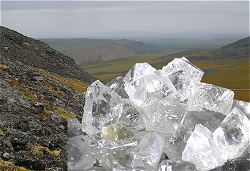
March Editorial
Canadian diamonds

March Editorial
Canadian diamonds
|
Not many people know that Canada is a major producer of diamonds. And that’s because Canada’s first commercial diamonds were produced only in 1998. Just 25 years ago no-one was even aware that Canada had any Kimberlite pipes. (Kimberlite pipes are vertical geological structures of volcanic rock which are often rich in diamonds.)
|
This changed in 1991 thanks to Chuck Fipke and Stewart Blusson, both geologists graduates of the University of British Columbia. the pair found evidence of diamond-bearing Kimberlite pipes about 200 miles north of the city of Yellowknife in Canada’s Northwest Territories. Stuart Blusson and Chuck Fipke first crossed paths in a dramatic manner. Chuck Fipke was stranded for almost a week on the side of a mountain. Blusson was the helicopter pilot who rescued him. After this encounter the two became friends and prospecting partners. |
|
|
One of the Kimberlite pipes discovered by Fipke and Blusson was soon confirmed to be a rich source of diamonds. The first Canadian diamond mine, Ekati, opened in 1998 as a joint venture between BHP (now BHP Billiton after 2001 merger of the Australian Broken Hill Proprietary Company Limited (BHP) and the Anglo-Dutch Billiton plc.) who owned 51%, Dia Met Minerals (29%) and Fipke and Blusson, both of whom had a 10% stake in the Ekati mine. The discovery of the diamonds in Northwest territories started some of the most intense mineral prospecting seen in North America since the gold-rush era. Thousands of prospectors came flocking to Canada to stake their claims. Lumber companies apparently sold out of the wood actually used for staking these claims. Diavik diamond mine was the second mine to be opened and is located not far from the Ekati. Diavik opened in 2003. Three years later Jericho mine, also in the same area, started production. In 2006 these three mines produced over 13 million carats of gem diamond and Canada became the third largest producer of diamonds in the world. Prospecting did not stop there. De Beers opened its first mine outside South Africa, near Snap lake (the Snap Lake Mine) in 2008. Soon after De Beers also opened its second diamond mine (the Victor Diamond mine) 50 miles west of Attawapiskat in the far north of Ontario. Canadian diamonds have quickly gained popularity. There are a number of reasons for this:
Diamond mining in Canada peaked in 2007 when production reached 18 million carats. In the next couple of years there was a steady decline, but since 2009 production has stabilised at just under 12 million carats a year. Diamond mining in Canada is not without its problems. Until recently most Canadian diamonds were mined in open pits which is the cheapest way to produce them. However, as this source has been exhausted, the ore body now requires underground mining. This increases the cost of production by about 50%. Secondly, most Canadian mines are in very remote places where road access is limited and the weather conditions are hostile for much of the year. Finally labor is considerably more expensive in Canada than, for example, in South Africa. But demand for diamonds is still very high, and although the pace of diamond prospecting in Canada has dropped considerably from the initial boom, promising new sites have been mapped in different parts of Canada, and these may in future turn into profitable mines. | |
| _______________________________ | ||||
| Home | | | Shopping | | | Database |
© Biscuit Software 2004-2015
All rights reserved